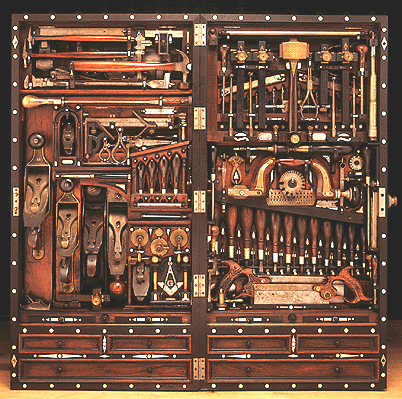Stu Miller posted this about his toolboxes:
About a year ago, I started two wooden machinist's toolboxes of my own design. They are now finished. Each is 12 by 18 by 10 inches deep




The lighter box is of oak with maple drawer fronts. The other is mahogany. The cases are joined with box joints with the backs rabbited in for strength. Drawer joints are an interlocking version I came up with that could be cut on my table saw. Drawer sides, backs, and guides are of maple salvaged from pallets. The drawer guide system duplicates my Gerstner box, including the bullet catches to prevent the drawers being pulled out too far. Drawer bottoms are sheet metal and are lined with butyl rubber/cork as per Paula's very brilliant suggestion on the Gerstner improvement thread.
The drawer pulls were made on my circa 1900 Pratt & Whitney No. 1 hand screw machine. Actually making the handles took about an hour. Setting up to make them took about a week. Probably not time efficient, but it was more fun than making them on my SB 9.
John Stevenson, on the HSM board, posted here and here about these:

I have made most of my own boxes with nothing more than a bench saw. I'm not the best woodworker either. Some while ago I bought a big load of oak Parkay flooring. At least that's what it's called in the UK. It's those wooden strip about 2" x 6" x 3/8" thick you lay in floors in a herringbone pattern.
These were being sold off.
I cut some 3/8" ply for the sides and back, just kept the good stuff for the fronts.
I sawed a groove in all the pieces just up from the bottom edge to hold the bottom which is fitted during assembly. The front and backs had a rebate at both sides to allow the sides to fit in and have a bigger glue joint. I engraved the fronts before assembly and glued and clamped these in a simple angle iron box frame and used wedges to clamp the pieces in.
The sides are just ply with a small strip of oak glue on to match the fronts.
I know there are faults with these but so what, I made them, I use them and I'm proud of them.
I have lined the bottom's, some with green felt soaked in inhibitor oil and some with foam carpet underlay when I ran out of felt {g}
Not quite as 'fine' as the ones above, but probably more practical for a workshop environment.
You could stack several of these if you needed to, and you wouldn't waste the space above. I could probably make some out of maple or oak, which would look nicer, but MDF is cheaper and faster to work with. But, it seems like if you're going to go through all that work to make it, and it's something you'll have for a long time, maybe it's worth the extra time to make it look good. Maybe I'll build one like H.O. Studley did:

:)
On the HSM board, Bill Pace posted his idea for using a broken band saw blade to hold up drawings and such. What caught my eye was the toolbox on his bench, which looks to be shop built (_not_ meant as a disparaging comment). This looks like it would be about ideal for my bench.

Woodcraft sells this plan that looks like it would be a nice box.
There's an article and plans about a nice toolbox in the Shopsmith Hands-On magazine here.